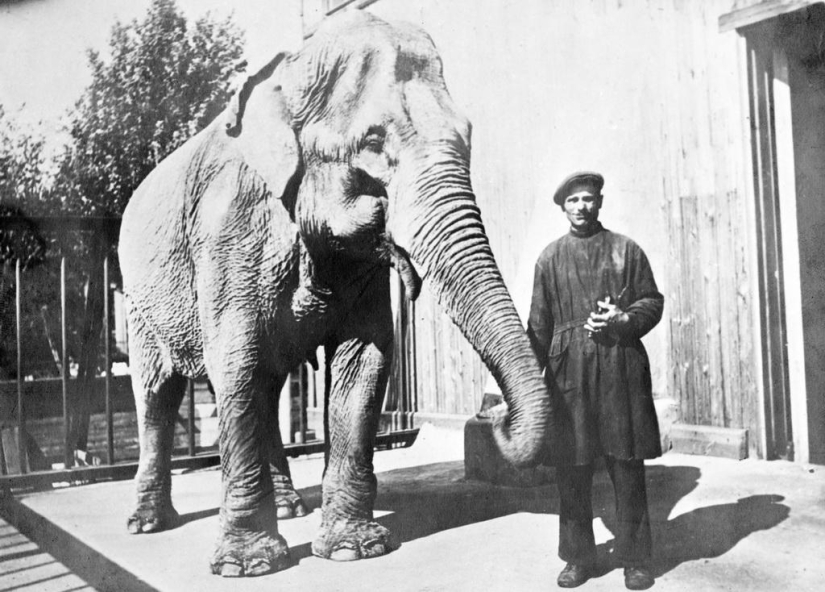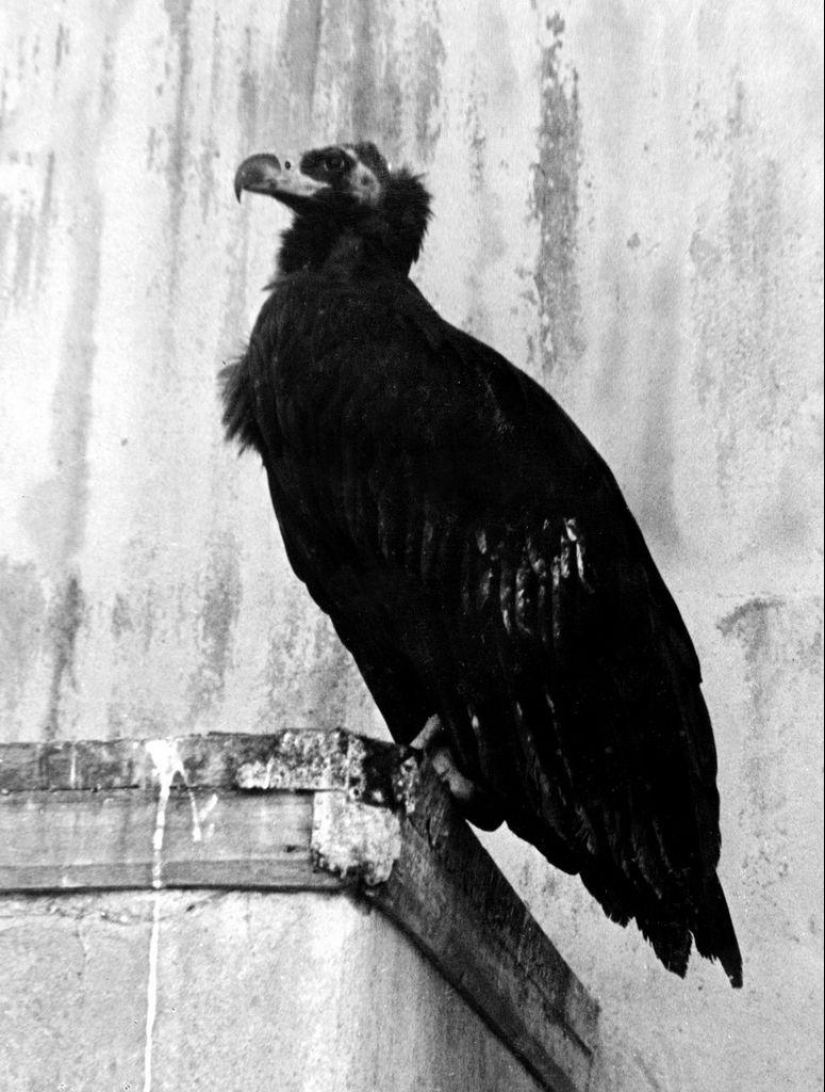How the Leningrad Zoo survived the blockade
The siege of Leningrad is one of the most terrible pages in the history of the city. The harsh winter of 1941-1942 completed what was started by the forces of the merciless enemy. It was hard for everyone, the inhabitants were dying of hunger and cold, it seemed that there was no help to wait for. However, even in those terrible times, there were people who, without sparing themselves, tried to save the unfortunate animals of the Leningrad Zoo.


1. V. K. Buryak and Betty the Elephant. 1932.
How is it possible to save more than 160 animals and birds in a city where enemy shells were constantly exploding on the streets, where the electricity supply was completely stopped, which led to the shutdown of water supply and sewerage, where the animals simply had nothing to feed?
Of course, the zoo staff tried to save the unique animals even before the siege began. About 80 animals were urgently taken to Kazan, including black panthers, tigers, polar bears, American tapir and a huge rhinoceros. However, all could not be taken away.

2. Entrance to the zoo. A postcard. 1920s.
About 60 inhabitants of the menagerie at the beginning of the war were in Belarus. They were brought to Vitebsk to demonstrate them to local children. However, the plans of the people were destroyed by the war that began so unexpectedly. Fleeing from the bombing, the staff of the zoo tried to protect as many animals as possible.

3. Among their wards was an American crocodile. Unfortunately, they could not take him out, as he needed special conditions to move around. Someone suggested releasing the crocodile into the waters of the Western Dvina, this idea was supported, and the thermophilic reptile went free swimming. No one ever found out about her fate.
In Leningrad itself, even before the bombing began, people were forced to shoot the remaining large predators. Of course, it was a pity for the innocent animals, but to leave them was to endanger the inhabitants of the city: once free, as a result of the destruction of the cages by shells, they could well go hunting.

4. Behemoth Beauty. 1935.
In early September, the 41st Leningrad was surrounded. By that time, the zoo still had bison, deer, Betty the elephant, Beauty the hippo, trained cubs, foxes, tiger cubs, a seal, two donkeys, monkeys, ostriches, a black vulture, and many small animals. Oh, and it was not easy for them during the bombing!

5. The ruins of the elephant house.
Most of the animals were rushing around in terror, the cubs were growling in fear, the birds were huddled in a corner, but the chamois, on the contrary, for some reason climbed the hill and stood there, waiting for the end of the shelling. Betty the elephant, as soon as she heard the sound of the siren, hurriedly went to her house. She had no other refuge. Unfortunately, on September 8, one of the three high-explosive bombs dropped from a German bomber exploded right next to her enclosure, killing the caretaker and fatally wounding Betty herself. The poor thing died 15 minutes later right on the ruins of the elephant house. She was buried on the territory of the zoo.

6. The dead Betty. September 10, 1941.
On that terrible night, smart bear cubs and funny fox cubs also died. The walls of the monkey house were destroyed, which caused the primates to run around. In the morning, employees gathered them, trembling with fear, all over the city. The unwieldy bison fell into the crater. The people simply didn't have the strength to pull him out, so they built a deck and lured him out with pieces of hay, spreading them from the bottom to the edge of the pit.

7. The ruins of the elephant house. 1941.
Another night, a goat and a couple of deer were wounded. An employee of Konovalov made bandages for the animals, shared her own bread with them and put them on their feet. However, the poor devils were killed during another attack, which also took with it tiger cubs and huge bison.

8. Places of bomb hits. 1941.
It was not easy for the hippo Beauty, who was brought to the zoo with Betty back in 1911. Of course, she was much more lucky than her unfortunate friend: she survived and lived a long happy life, but without the selfless help of Evdokia Dashina, the miracle would not have happened. The fact is that the skin of the hippo must be constantly moistened with water, otherwise it quickly dries up and becomes covered with bloody cracks. And in the winter of the 41st, the city's water supply did not work and the Beauty's pool remained empty.

9. E. I. Dashina at the behemoth Beauty. 1943.
What to do? Evdokia Ivanovna brought a forty-bucket barrel of water every day on a sledge from the Neva River. The water was heated, and the poor hippopotamus was watered with it. Cracks were smeared with camphor ointment, spending up to a kilogram a day. Soon, the Beauty's skin healed, and she was able to hide under the water with dignity during the bombing. She lived until 1951 and died of old age, without having earned a single chronic disease. "Here it is, the blockade hardening!" — the veterinarians later said with admiration.

10. A group of camels on the background of a roller coaster. 1936.
Of course, in those terrible years, the zoo was not funded, and the survival of the animals depended entirely on its employees. In the first months of the war, they collected the corpses of horses killed by shells in the fields, risking their lives, and removed vegetables from the fields. When this opportunity was lost, people mowed the remaining grass with sickles in all possible points of the city, collected mountain ash and acorns. In the spring, the entire free territory was turned into vegetable gardens, where cabbage, potatoes, oats and rutabaga were grown.

11. Black vulture Verochka. 1946.
But this way you can only save vegetarian animals, and what about the rest? If the cubs, outraged, still ate minced meat from vegetables and herbs, then the tiger cubs and vulture completely abandoned such a diet. For their sake, they found the rabbit skins that were lying around, stuffed them with a mixture of grass, cake and gristle, and smeared the carcasses outside with fish oil. So it was possible not to let the fastidious predators die of hunger.

12. Antelope Nilgau Lighthouse. 1946.
For birds of prey, fish was added to this mixture. The vultures agreed to eat only soaked salted fish. But the most intractable was the golden eagle, for which people had to catch rats.
It is known that an adult hippo should receive from 36 to 40 kg of feed per day. Of course, in the years of the blockade, there could be no question of such a "feast". The beauty was given 4-6 kg of a mixture of herbs, vegetables and cake, adding 30 kg of steamed sawdust, just to fill her stomach.

13.The site of young animals. 30s.
In November 1941, the zoo was replenished: the hamadryad Elsa had a baby. The mother had no milk, but the local maternity hospital allocated a little donor milk every day, so that the hamadryad could survive.
Surprisingly, however, the Leningrad Zoo was closed only in the winter of 1941-1942. Already in the spring, exhausted employees cleared the paths and repaired the aviaries to let the first visitors in the summer. 162 animals were exhibited. During the summer, about 7,400 Leningraders came to see them, which proved the need for such a peaceful institution in those terrible years.

14. The collective of the Lenzoosad. Spring of 1945.
Many ministers spent the night right in the zoo, not wanting to leave their wards for a moment. There weren't many of them — only two dozen-but it was enough to save many lives. 16 people were awarded the medal "For the Defense of Leningrad", and the zoo itself was decided not to be renamed in order to preserve the memory of the feat of the blockade workers.
Keywords: Zoo | Animals | Russian federation | History | World war II | Survival | Famine | Leningrad | Blockade
Post News ArticleRecent articles

Most of us loved as kids magic tricks, but someone loves them right now. However, the attitude to the hoax became a few others ...

Everything is changing. This is well and has long been known to everyone. But when something stays with you for a long time, it is ...
Related articles

Beloved by many, actor Mikhail Boyarsky has always been distinguished not only by his cheerful disposition and desperate, sometimes ...

A series of works by photographer Brian VILS from new York, dedicated to girls, sheltered the homeless and abandoned cats. 'brien ...

Life with Pets is always fun. Why are only their daily funny antics, which make us laugh to tears, and love them even more. The ...

Compared to the 1970-ies 1980‑e years were a time of cautious optimism in new York. Boom on wall street fueled the speculative ...